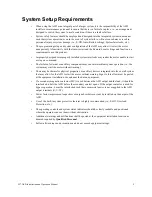
W7 ASD Installation and Operation Manual
21
W7 ASD Control
The Control PCBA (P/N 56000) serves as the primary control source for the W7 ASD and receives
input from the
Control Terminal Strip
PCBA
, an Option Card, RS232/RS485 Communications, or the
W7 ASD Keypad
.
The Control PCBA has been enhanced to support two new functions: Multiple Protocol
Communications and the ability to communicate in either half- or full-duplex modes.
Using the optional multiple-protocol communications interface: the ASD-NANOCOM, the Control
PCBA may be configured for the type of communications protocol being received and respond
appropriately to the sending device. The ASD-NANOCOM connects to the J4 and J5 connectors
(see
Figure 6
). A jumper PCBA (P/N 55365) is required at the J4 connector if not using the ASD-
NANOCOM.
The ASD-NANOCOM must be setup to support the desired communications protocol via Program
⇒
Comm Settings. Consult the ASD-NANOCOM User’s Manual (P/N 10572-1.000-000) for a complete
listing of the setup requirements.
Half or Full duplex communications is available when using RS232/RS485 communications. The
jumpers at the JP1 and the JP2 connectors may be moved from one position to the other to facilitate
either half- or full-duplex operation. If no jumpers are used the system will operate in the full duplex
mode.
For more information on the W7 ASD communication requirements, please visit
WWW.TIC.TOSHIBA.COM to acquire a copy of the 7-Series Communications User Manual
(see Literature
⇒
Manuals
⇒
Drives Manuals) and WWW.ICCDESIGNS.COM to acquire a copy of
the ASD-NANOCOM User Manual.
Contact your Toshiba representative if more information is required on the ASD-NANOCOM.
Figure 6. Control Board of the W7 ASD (P/N 56000).
25-pin D-type connector.
Connects to the Control
Terminal Strip PCBA
(CN7)
.
RS232/RS485 signal I/O
(
CNU1
).
Common Serial (TTL) I/O
(
CNU2
).
CNU3
CN2
CNU8
CNU4
JP1 Jumpers — Half-/Full-Duplex selection.
RS232/RS485 signal I/O
(
CN3).
ASD-NANOCOM.
















































